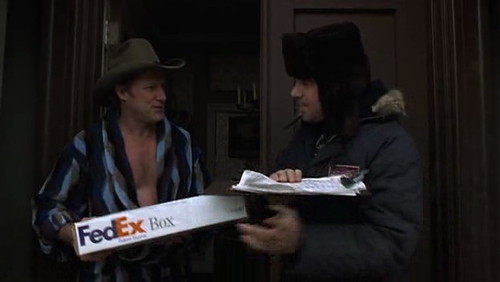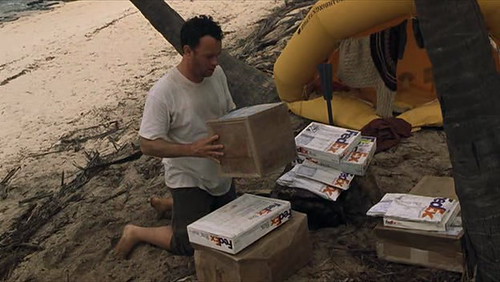On Friday, 19th November, an interesting debate started on social news website Reddit: What Movies Have Had the Worst Product Placement? The user, who opened the topic, presented his/her idea: “Here’s mine: Minority Report. I liked this movie, but at points it seems like a giant commercial: Guinness, Lexus, Gap, USA Today, and Pepsi. Every time I watch it now I seem to notice the products they shill than the actual movie itself.”
Before I give my opinion on this topic, let’s see some examples from Reddit’s thread (those with the most comments).
The Thomas Crown Affair
The Thomas Crown Affair from 1999 includes very prominent Pepsi placement. One Reddit user argued that he/she started laughing hard when she (Rene Russo) drinks the soda – it was a 30 second commercial within a film.
I, Robot
Will Smith’s movie I, Robot had a very visible product placement: Converse sneakers, vintage edition. The movie takes place in the future, and there is a scene when Will Smith opens up the package and is very excited about his sneakers. Later in the movie some characters commented on his sneakers and he said that he wears Converse.

The Island
One Redditor said: “I saw The Island in theaters, I walked away rather perturbed that I had actually paid to watch two hours worth of commercials.”
Transformers
“Transformers was a 2 hour ad for the Army/Navy/Air Force sponsored by GM products. Don’t forget the Mt. Dew, Xbox 360 and Nokia ads they throw out every few minutes.”
Cast Away
“I often wonder if FedEx paid them to write the part in about him delivering that package at the end.”

James Bond movies
Quantum of Solace: “It’s the only thing you can see clearly in the film.”
The train scene in Casino Royale: “Eva Green: “Rolex?” Daniel Craig: “Omega” Eva Green: “Beautiful” … They didn’t even try.”
The Perrier truck in Goldeneye: “Bond has stolen a tank and is rampaging around St. Petersburg in it, taking out buildings and occasionally crushing one of the police cars chasing him around town. At one point he drives the tank straight through this enormous Perrier truck. In effect, a massive billboard reading “Perrier” fills the center of the screen, and then Bond smashes through it in his tank. I swear, this truck must have been carrying enough Perrier to meet St. Petersburg’s demand for the next two hundred years!”
What exactly is bad product placement?
 I posted some examples of “bad” product placement from various people from all over the world. But are these placements really the worst of the worst. Remember, product placement can be visual or spoken or can be used on screen. Placement can be a logo, a brand name, a product or packaging. Jean-Marc Lehu has written in his book Branded Entertainment that product placement in its least elaborate form merely allows for the appearance of a brand or product onscreen. In its most effective form, it is so integrated into the storyline that its presence seems logical, even indispensable.
I posted some examples of “bad” product placement from various people from all over the world. But are these placements really the worst of the worst. Remember, product placement can be visual or spoken or can be used on screen. Placement can be a logo, a brand name, a product or packaging. Jean-Marc Lehu has written in his book Branded Entertainment that product placement in its least elaborate form merely allows for the appearance of a brand or product onscreen. In its most effective form, it is so integrated into the storyline that its presence seems logical, even indispensable.
Lehu has given some recommendations for effective placements:
Defining the objective and the attraction of the placement
- Ensuring a positive presence onscreen
- Establishing a placement contract
- Maximizing the prominence and visibility of the placement
- Obtaining a central location onscreen
- Negotiating and controlling integration into the story
- Signing a detailed partnership contract as far in advance as possible
Let’s now define bad product placement. In my opinion a product placement can be bad either for a brand and/or for moviegoers:
a) Brand
- Let’s assume that a company decided to use product placement for one of its brands. One of the worst things that can happen to a brand is lack of movie success at the box office. The company tried to find the best way of promoting its brand but to no effect.
- Let’s assume that a company had nothing to do with a particular product placement. That could happen and can be quite dangerous for a brand. You’ll never know if your brand will be mocked, will be use in an offensive way, it can be used by a bad guy …
The positive or negative effect of product placement on behalf of a brand can only be evaluated if the company had set specific goals for the placement. Sometimes you (as the viewer) might not like the placement; nevertheless it achieved its goal(s).
b) Moviegoers
Here’s the tricky part. Each movie fan has a unique relationship with a certain movie and at the same time with a certain brand. You have to add moviegoer’s expectations towards a movie, daily mood, previous experience with actors/director/brand … The list can be very long. Those factors could influence moviegoer’s feeling about a product placement.
Let’s briefly check two examples:
In my previous post Product placement Hall of Shame – Heineken in Wall Street: Money Never Sleeps I analysed a case of “bad” product placement. At least I thought it was. My main objection was about the context: the placement was forced rather than natural. Even though I like Oliver Stone, Michael Douglas, Gordon Gekko, the first Wall Street movie and I have slightly positive attitude towards Heineken, for me the product placement was awful. However, that only influenced my general opinion on Oliver Stone and the movie, but I haven’t changed my feelings about Heineken.
A lot of moviegoers complain about FedEx product placement in the movie Cast Away (there is an example above), but for me that product placement works. It was put in the context of the story. It could’ve been any shipment company instead of FedEx; however it would look silly and unrealistic if there was a fictional company involved.

So, next time you’ll discuss good or bad product placement think about the brand owner, the context of the story and think about your point of view. Would your opinion change, if you were in a different mood? Would you rate a movie differently, if there was no product placement or do you think that the brand added something important to the story?

Worst case of product placement? It’s gotta be this one: http://www.youtube.com/watch?v=14mbLxfSuDs Thes scene shows a meeting of the city council…And yes, it’s a Polish movie – from 1991 I guess (by Kazimierz Kutz). As a Pole, I can’t say I’m proud…
OMG! This is really awful!
We all think that its bad product placement, but its a again a matter of taste and at the end, the movie brings a positive feeling towards the brand, like in I, ROBOT. It stays in mind and the main charakter loves the shoes.
i think it would be bad product placement, when the product is used in a negative way. When for example the new fiat has a crush and the engine doesnt work anymore.
Are there any examples?
Well, we could say that there is negative product placement, which happens when your brand is used in a negative way, is mocked, used in an inappropriate situations …
However, we could also say that there is bad product placement, which is a matter of taste and I agree with you completely. Bad product placement is debatable. I’ve posted several examples as product placement prostitution. In some cases you might agree with me :)